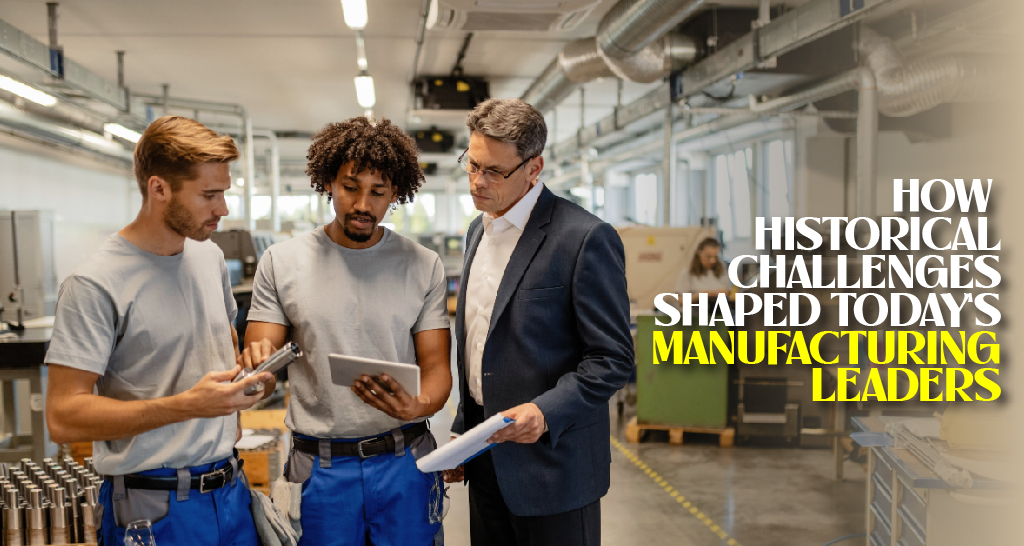Imagine stepping into a time machine and zipping back through the years to see how factories and workshops used to be. Back then, things were really different. There were no fancy machines or computers, just a lot of hard work and big ideas.
Now, back to reality. Look around at the modern manufacturing world. It’s fast, smart, and always changing. But have you ever thought about what connects the past with now?
Well, it’s the challenges along the way and the people who faced them head-on. These challenges didn’t just change how things are made; they created a new breed of leaders.
This post is about how tough times in the past shaped these cool leaders of today. You’ll see how every big problem they solved taught them something new, preparing them for anything the future throws their way.
So, let’s dive right in!
The Foundation: Learning from the Past
As you know, manufacturing didn’t just appear out of thin air. It’s a result of centuries of evolution, shaped by countless challenges. Think about the Industrial Revolution, a time when industry changed a lot.
This era wasn’t just about steam engines and mechanization; it was a breeding ground for leadership and resilience. Much like today’s leaders, leaders of that era had to fix several tough situations.
They faced logistical nightmares, labor disputes, and technological limitations. Yet, these adversities didn’t deter them. Instead, they learned, adapted, and evolved. This resilience is something you can still see in today’s manufacturing leaders.
Innovation Through the Ages
The journey of manufacturing is marked by constant innovation. This innovation wasn’t limited to technology alone; it also encompassed how leaders thought and approached challenges. A prime example of this enduring spirit of innovation can be found when exploring the butler history. This narrative showcases how companies like Butler Manufacturing, established in the early 20th century, continually adapted to changing market demands and technological advancements, setting a precedent for today’s manufacturing leaders.
These leaders didn’t just react to changes; they anticipated and led them. They fostered a continuous improvement culture, a cornerstone of modern manufacturing practices.
The Digital Age: Embracing Technology
Now, consider the digital age, a period you are undoubtedly familiar with. This era brought about automation, AI, and digital manufacturing.
Today’s leaders didn’t just witness this transformation; they were the architects of it. They saw potential in these new technologies and integrated them into traditional manufacturing processes.
This willingness to embrace change and leverage technology for improvement is a trait that distinguishes today’s manufacturing leaders. They’re not just managers but visionaries who see beyond the horizon.
Sustainability: Responding to a Global Call
In recent years, there’s been a growing emphasis on sustainability. It’s a challenge that exceeds industries, and manufacturing is no exception. Today’s leaders are not just focusing on production and profit but also champions of sustainable practices.
This shift towards sustainability is not just about compliance; it’s about responsibility. Manufacturing leaders are now at the forefront of this movement, innovating to reduce waste, conserve energy, and minimize environmental impact.
Crisis Management: Learning from the Pandemic
The COVID-19 pandemic posed a unique challenge. It disrupted supply chains, halted production, and necessitated a rapid shift in operations. Manufacturing leaders had to be more agile and resilient than ever. They had to find new ways to keep production lines moving while ensuring the safety of their workforce.
This crisis brought out the best in these leaders. They demonstrated remarkable adaptability, quick thinking, and a commitment to their teams and customers. This ability to navigate crises sets today’s manufacturing leaders apart.
Globalization: The World as a Connected Market
As the world became more connected, the manufacturing sector faced a new set of challenges: globalization. This era significantly shifted from local or national production to a global marketplace. Manufacturing leaders had to rethink their strategies, adapting to different cultures, regulations, and consumer needs across continents.
The expansion into global markets wasn’t easy. It required a deep understanding of diverse markets and the ability to manage complex international supply chains. Leaders who excelled during this phase were those who embraced cultural diversity and fostered international collaboration.
Wrapping It All Up
As you reflect on these historical challenges, it’s clear that they didn’t just shape the manufacturing industry; they molded the leaders within it. Today’s manufacturing leaders are a product of this rich history. They embody resilience, adaptability, innovation, and a commitment to sustainability and social responsibility. Their journey reminds them that challenges aren’t just obstacles; they’re opportunities to grow, learn, and lead. So, as you move forward in your career in manufacturing, remember the lessons from the past. They’re not just stories but blueprints for success in an ever-evolving industry.

